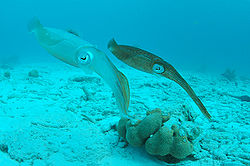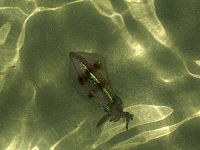
Caribbean Reef Squid
Encyclopedia
The Caribbean Reef Squid (Sepioteuthis sepioidea), also known as just the Reef Squid, is a small (20 cm) torpedo
-shaped squid
with fin
s that extend nearly the entire length of the body and undulate rapidly as it swims. The squid has recently become notable when it was discovered that it could fly out of the water; a discovery which finally led to identification of six species of flying squid.


 The Caribbean Reef Squid is found throughout the Caribbean Sea
The Caribbean Reef Squid is found throughout the Caribbean Sea
as well as off the coast of Florida, commonly in small schools
of 4-30 in the shallows associated with reef
s. The habitat
of the Reef Squid changes according to the squid's stage of life and size. New hatchlings tend to reside close to the shore in areas from 0.2-1 meters below the surface on or under vegetation
. Young small squid typically congregate in shallow turtle grass near islands and remain several centimeters to two meters from the surface to avoid bird predators. Adults venture out into open water and can be found in depths up to 100 m. When mating, adults are found near coral reefs in depths of 1.5-8 m. The Caribbean Reef Squid is the only squid species commonly sighted by divers over inshore reefs in the Florida, Bahamas and Caribbean region.
s which are then pulled towards the mouth supported by the shorter arms
. Like other cephalopods, it has a strong beak
which it uses to cut the prey into parts so that the raspy tongue, or radula
, can be used to further process the food. It consumes small fish, other molluscs, and crustacean
s.
s. In addition to camoflauge and appearing larger in the face of a threat, squids use color, patterns, and flashing to communicate with one another in various courtship rituals. Caribbean Reef Squid can send one message via color patterns to a squid on their right, while they send another message to a squid on their left.
then die immediately after. The males, however, can fertilize many females in a short period of time before they die. Females lay the eggs in well-protected areas scattered around the reefs. After competing with 2-5 other males, the largest male approaches the female and gently strokes her with his tentacles. At first she may indicate her alarm by flashing a distinct pattern, but the male soon calms her by blowing water at her and jetting gently away. He returns repeatedly until the female accepts him, however the pair may continue this dance or courting for up to an hour. The male then attaches a sticky packet of sperm
to the female's body. As he reaches out with the sperm packet, he displays a pulsating pattern. The female places the packet in her seminal receptacle, finds appropriate places to lay her eggs in small clusters, and then dies.
Torpedo
The modern torpedo is a self-propelled missile weapon with an explosive warhead, launched above or below the water surface, propelled underwater towards a target, and designed to detonate either on contact with it or in proximity to it.The term torpedo was originally employed for...
-shaped squid
Squid
Squid are cephalopods of the order Teuthida, which comprises around 300 species. Like all other cephalopods, squid have a distinct head, bilateral symmetry, a mantle, and arms. Squid, like cuttlefish, have eight arms arranged in pairs and two, usually longer, tentacles...
with fin
Fin
A fin is a surface used for stability and/or to produce lift and thrust or to steer while traveling in water, air, or other fluid media, . The first use of the word was for the limbs of fish, but has been extended to include other animal limbs and man-made devices...
s that extend nearly the entire length of the body and undulate rapidly as it swims. The squid has recently become notable when it was discovered that it could fly out of the water; a discovery which finally led to identification of six species of flying squid.
Distribution and habitat



Caribbean Sea
The Caribbean Sea is a sea of the Atlantic Ocean located in the tropics of the Western hemisphere. It is bounded by Mexico and Central America to the west and southwest, to the north by the Greater Antilles, and to the east by the Lesser Antilles....
as well as off the coast of Florida, commonly in small schools
Shoaling and schooling
In biology, any group of fish that stay together for social reasons are said to be shoaling , and if, in addition, the group is swimming in the same direction in a coordinated manner, they are said to be schooling . In common usage, the terms are sometimes used rather loosely...
of 4-30 in the shallows associated with reef
Reef
In nautical terminology, a reef is a rock, sandbar, or other feature lying beneath the surface of the water ....
s. The habitat
Habitat (ecology)
A habitat is an ecological or environmental area that is inhabited by a particular species of animal, plant or other type of organism...
of the Reef Squid changes according to the squid's stage of life and size. New hatchlings tend to reside close to the shore in areas from 0.2-1 meters below the surface on or under vegetation
Vegetation
Vegetation is a general term for the plant life of a region; it refers to the ground cover provided by plants. It is a general term, without specific reference to particular taxa, life forms, structure, spatial extent, or any other specific botanical or geographic characteristics. It is broader...
. Young small squid typically congregate in shallow turtle grass near islands and remain several centimeters to two meters from the surface to avoid bird predators. Adults venture out into open water and can be found in depths up to 100 m. When mating, adults are found near coral reefs in depths of 1.5-8 m. The Caribbean Reef Squid is the only squid species commonly sighted by divers over inshore reefs in the Florida, Bahamas and Caribbean region.
Feeding behavior
This species, like most squid, is a voracious eater and typically consumes 30-60% of its body weight daily. Prey is caught using the club-like end of the long tentacleTentacle
A tentacle or bothrium is one of usually two or more elongated flexible organs present in animals, especially invertebrates. The term may also refer to the hairs of the leaves of some insectivorous plants. Usually, tentacles are used for feeding, feeling and grasping. Anatomically, they work like...
s which are then pulled towards the mouth supported by the shorter arms
Cephalopod arm
A cephalopod arm is distinct from a tentacle, though the terms are often used interchangeably.Generally, cephalopod arms have suckers along most of their length, as opposed to tentacles, which have suckers only near their ends. Octopuses have eight arms and no tentacles, while squid and cuttlefish...
. Like other cephalopods, it has a strong beak
Beak
The beak, bill or rostrum is an external anatomical structure of birds which is used for eating and for grooming, manipulating objects, killing prey, fighting, probing for food, courtship and feeding young...
which it uses to cut the prey into parts so that the raspy tongue, or radula
Radula
The radula is an anatomical structure that is used by molluscs for feeding, sometimes compared rather inaccurately to a tongue. It is a minutely toothed, chitinous ribbon, which is typically used for scraping or cutting food before the food enters the esophagus...
, can be used to further process the food. It consumes small fish, other molluscs, and crustacean
Crustacean
Crustaceans form a very large group of arthropods, usually treated as a subphylum, which includes such familiar animals as crabs, lobsters, crayfish, shrimp, krill and barnacles. The 50,000 described species range in size from Stygotantulus stocki at , to the Japanese spider crab with a leg span...
s.
Communication
Caribbean Reef Squid have been shown to communicate using a variety of color, shape, and texture changes. Squid are capable of rapid changes in skin color and pattern through nervous control of chromatophoreChromatophore
Chromatophores are pigment-containing and light-reflecting cells found in amphibians, fish, reptiles, crustaceans, and cephalopods. They are largely responsible for generating skin and eye colour in cold-blooded animals and are generated in the neural crest during embryonic development...
s. In addition to camoflauge and appearing larger in the face of a threat, squids use color, patterns, and flashing to communicate with one another in various courtship rituals. Caribbean Reef Squid can send one message via color patterns to a squid on their right, while they send another message to a squid on their left.
Reproduction
Like other cephalopods, the Caribbean Reef Squid, is semelparous, dying after reproducing. Females lay their eggsEgg (biology)
An egg is an organic vessel in which an embryo first begins to develop. In most birds, reptiles, insects, molluscs, fish, and monotremes, an egg is the zygote, resulting from fertilization of the ovum, which is expelled from the body and permitted to develop outside the body until the developing...
then die immediately after. The males, however, can fertilize many females in a short period of time before they die. Females lay the eggs in well-protected areas scattered around the reefs. After competing with 2-5 other males, the largest male approaches the female and gently strokes her with his tentacles. At first she may indicate her alarm by flashing a distinct pattern, but the male soon calms her by blowing water at her and jetting gently away. He returns repeatedly until the female accepts him, however the pair may continue this dance or courting for up to an hour. The male then attaches a sticky packet of sperm
Sperm
The term sperm is derived from the Greek word sperma and refers to the male reproductive cells. In the types of sexual reproduction known as anisogamy and oogamy, there is a marked difference in the size of the gametes with the smaller one being termed the "male" or sperm cell...
to the female's body. As he reaches out with the sperm packet, he displays a pulsating pattern. The female places the packet in her seminal receptacle, finds appropriate places to lay her eggs in small clusters, and then dies.

